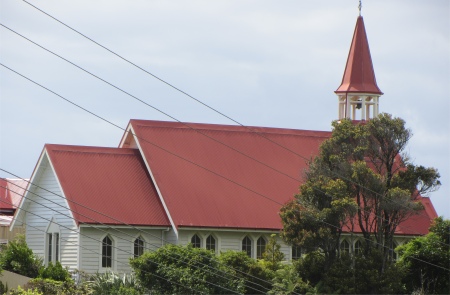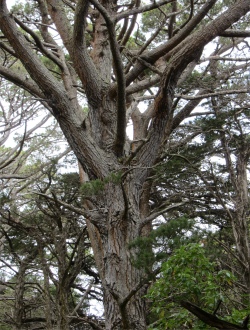
Oban Presbyterian Church
|
Stewart Island, New Zealand's third main island, is located off the beaten track about 25km south of Bluff. The island was named after William Stewart, first officer of the sealing vessel
Pegasus, which was the first ship to circumnavigate the island. There is a mystique about the island that cannot be found elsewhere in New Zealand. Numerous islands dot the shoreline, and densely forested hills descend to a coastline of rocky outcrops and creamy golden sand beaches. It is a natural refuge for marine and bird life.
Vivid dawn and twilight hues give rise to the island's Maori name,
Rakiura, "land of the glowing skies".
On arrival at Oban in Halfmoon Bay, a small fishing village that served as the link with the mainland. I did a quick tour of the local streets, which didn't take long, the highlight being a climb up to Observatory Rock to get an excellent view across Paterson Inlet. The island is 65km long and 40km at its widest point, but has only 20km of roads, most of them private. The islands population is small, and the telephone directory fits onto one page with room to spare.
85 per cent of the island was designated as the Rakiura National Park, and to scratch just the surface of this, I opted for the Paterson Inlet cruise, which included a tramp through part of the native rain forest.

Oban
|
We were seven hardy souls who ventured out onto the waters, passing sandy coves, windswept beaches, and bush-fringed bays enclosing a rugged interior of granite outcrops overrun with tall rimu forest. We tracked the coast for a while, with one of the crew giving a commentary about the sea birds wheeling about. One variety in particular that followed our vessel was a group of Mollyhawks, a smaller version of albatross. The occasional blue penguin could be seen in the water. Seals and sea lions were taking a break elsewhere. As we toured the coast around Paterson Inlet, sites of former milling stations were pointed out. Norwegian ships worked around Ross Bay in Antarctica, and when the seas froze over, the mother ship would return to Norway with the products obtained from their activities, while the smaller vessels anchored up for the winter in Paterson Inlet. The location where they anchored once had a large workshop, but now all that remained was a rusty old steam boiler, and the remnants of a slipway.

Robin
|

Lady's Slipper Orchid
|
We headed across to Ulva Island, the furthest south I'll probably ever get in my lifetime, Here we disembarked for a guided hike through rain forest. The island was home to endangered flora and fauna, some of which were indigenous to the island. Predators had been successfully removed from the island, though there seemed to be an on-going lookout for stowaway rats invading the island.
This was a fascinating tour where we spotted a red crested parrot, tui, a robin (with a white breast), and a bellbird. We came across stands of miro, rimu, rata and totara. The latter tree was of interest to us and parrots. Parrots would dig holes in them when the trees were young, and as the trees grew older, bugs would invade the hole and start to make the hole bigger. The parrots returned to feed on the bugs. What was remarkable was that the trees survived, even with gaping holes running through them. Our guide also pointed out a rimu tree adjacent to a pine tree, both of the same diameter. The rimu was 600 years old, the pine just 20. The slow growth rate of the rimu made for a very dense wood.

Rimu
|
We came across all sorts of mosses and ferns that would not be out of place when the ancient coal seams were formed, though the ferns then would have been enormous because of the abundance of carbon dioxide at the time. One intriguing plant that our guide pointed out was a tmesipteris. This plant was considered to be the link between mosses and lichens, and the rest of the evolutionary trail of plants that had stems and veins. It was a small plant with no roots, just an anchor and its leaves were considered to be more scales than leaves. Marvellous. Another remarkable example of evolution was a tree whose name I cannot recall. The younger version had leathery leaves with sharp points, but after 20 years of growth, when the leaves were too high for even giant moa birds to reach, the leaves gradually changed into succulent smooth versions.
It was an excellent excursion, and I would recommend it to anyone. I managed to arrive back at Oban just in time to catch the ferry back to Bluff. The ferry trip across the Foveaux Strait was as rough as before, and people were feeling a wee bit queasy, but they all survived.
I got back to camp where I met up with Aaron again. He wanted to go crayfishing today, but because of the state of the seas, the water was too murky for him. He caught crayfish by simply diving down and grabbing them from behind before they pinched. They breed them hard here. He was off to shear another herd of sheep in the morning, and he was looking forward to it. "Shearing the first ten sheep is the worst, it is back breaking. Then it gets better and I can handle it. But when I have had about three days with no shearing, my back ache returns, and I look forward to going back to shearing to get rid of the pain. It takes it out of your body, shearing does," he told me. He went off to party with a gang of Maori who had removed all but one of the tables out of the communal kitchen and set them up outside. These guys were all covered in traditional Maori tattoos; I wasn't going to argue with them.






